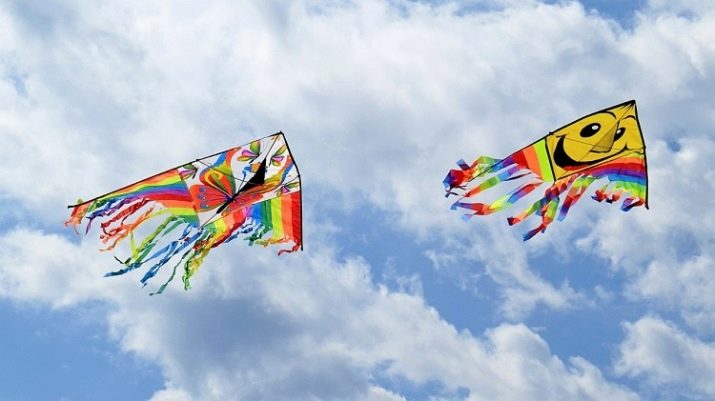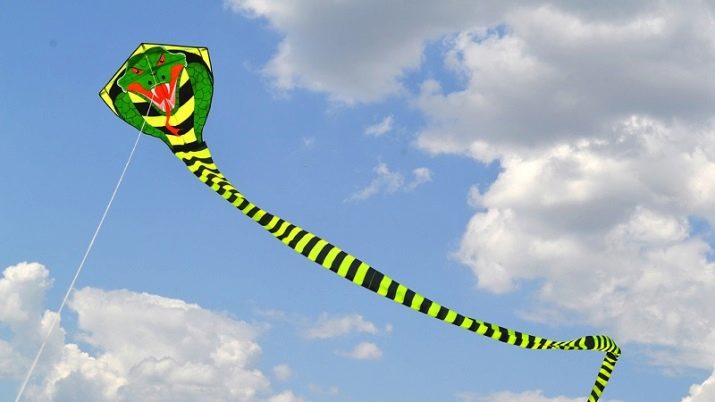All about kites

A kite is romance, passion and beauty in one bottle. Those who read the stories of V. Krapivin in childhood will probably remember how enthusiastic his heroes were about creating kites, how many interesting details in this matter, how exciting the first launch of a homemade kite is. By the way, this topic is not outdated at all. And even actively developing.






What it is?
A kite is an aircraft that holds a person on the ground with the help of a rail, and the force of the wind lifts him from the ground. It is interesting that today there is a whole sport dedicated to the launch of air figures, and it is called kiting. The athlete must move around on a device, such as a snowboard or surfboard, and use the force of the kite's thrust.
Also, kites are actively used in panoramic photography, they are great help for professional advertising visualization. In this case, the designs can be both complex, highly professional, and amateur.


The main tool that will be required to control the kite is the wind. You can, of course, imitate it, but this makes the task more difficult: you have to maintain speed all the time. A kite is comparable to a sail that stays afloat for a long time as long as it is exposed to forces. The wind itself raises the structure, moves it.
Gravity acts on the structure, but it still floats with air resistance. Of course, for the process to be long and beautiful, you need to properly design the snake itself. It will not be an exaggeration to say that such construction is a whole art.


It would seem that today it is more interesting for a child to receive a "drone" as a present, much more technological and modern. But the kite is actually the first man-made flying machine. Therefore, it is logical that a child must follow the path of a person: from a simple paper flying rhombus to a super-complex and ingenious technique. In addition, in relation to the kite, the controller feels more like a creator. And if he makes the apparatus himself, emotions are even more exciting.
To understand how he flies, thanks to what and how it happens, is very useful for children. These are physics lessons, and natural history, and just a wonderful design and emotional experience. Therefore, kites are not only for entertainment.
This experience can become a hobby for both a child and an adult.


History of origin
When exactly the first serpent was created, it is impossible to say for sure. But it is absolutely certain that in the second century BC it already existed. This is evidenced by Chinese documents found by archaeologists of that time. The material for the creation of the snake was bamboo, paper, and silk. And why exactly the "snake" is easy to guess. Anyone who knows at least something about the culture of China understands the significance of the dragon figure in it. They were made just huge, incredibly impressive, mystical. The dragon's face was bright and bared. His tail fluttered in the wind, the figure was decorated with feathers and ribbons, lanterns and even all kinds of sound effects.
If the dragon also sounded, it made an indelible impression. Flying dragons were a regular feature of folk festivals. And this tradition has not outlived itself, dragons are still extremely popular in China. Flying toys have also become interesting to the neighbors of the Chinese. Figures began to appear in Korea, Malaysia, Japan, and in each country the dragon turned out to be interesting and special in its own way. National cultural traits were guessed in his figure. And then the flying dragon began to take on new forms: butterflies, fish, birds, mystical warriors began to soar into the sky. In the early Middle Ages, such devices appeared in Europe.


In the 18th century, a new purpose was invented for flying toys - they became meteorological instruments. At first, with their help, they simply studied natural phenomena: the same "behavior" of the wind. By the end of the 19th century, a box kite was created, which greatly helped the development of aeronautics. It was he who became the prerequisite for the creation of the first airplanes. By the way, the same box model helped Marconi establish the first radio communication across the Atlantic.
There is also speculation that snakes could also be in Ancient Rome and Ancient Greece. But still, there is no convincing evidence of this, so flying figures have become a national treasure of China. Weifan City hosts the annual Kite Film Festival. Admirers of this hobby and aircraft manufacturers also gather there.
Watching videos and photos from this festival (and others like it) inspire many people around the world to create their own products.


Description of species
To a person far from kiting, it may seem that the kite is a small paper diamond that children (mostly) launch into the sky. This idea is erroneous, because products are very different: not necessarily paper, equipped with a camera, inflatable, etc. But the main classification lies in the principle of control of the apparatus.



Uncontrollable
Actually, the main advantage of this design is already guessed in the name. This aircraft is autonomous. It can be lifted into the air and tied to a rope: the snake itself will wriggle up above until the wind dies down. What is great about it is the ability to launch several figures at once for one person. The uncontrollable design allows you to play with different elevators, raise photo and video equipment. To surprise a child, just such a device is needed. For example, he can raise his beloved bear and baby and give him the opportunity to fly, which will delight the owner of the toy.
Types of uncontrollable kites:
- deltas (triangles);
- rokkaku (hexagons);
- Russian serpent (square);
- eddie (rhombus or diamond).



The easiest way to find on sale is a delta-shaped snake, a single-line snake is also often found. But devices without a frame are more difficult to find. Uncontrollable structures are often made of composite materials and synthetics, for example, carbon fiber or carbon fiber. They are lightweight, but very durable. If a person decides to make a simple snake himself, then the kit for its manufacture may include paper or bamboo, plastic tubes. And if you assemble it correctly, it will fly no worse than the purchased one.
Sizing is also important, especially for those new to kite flying. Size affects the thrust and the difficulty of the launch itself. A huge snake is much harder to lower to the ground, because it pulls harder.
If the snake is intended for a child, a meter-long specimen is enough for him. Professionals are ready to send a thirty-meter structure to fly.

Managed
Again, the main advantage of such models is also in the name: they need to be controlled, which in itself is interesting, technologically advanced, and exciting. A person does not just hold in his hand a rope with a lath-and-fabric structure at the other end. He himself is the controller of a small but perfect aircraft. He, the apparatus, will respond to the commands of a person on earth. It is the person who creates the bend of the serpent, he also saves him from falling.
True, it will not work to distract from such management, alas. You need complete concentration. And even transferring control to another is a problem. This should be a person who understands what falls into his hands. Again, it is extremely difficult to launch a steerable structure in low winds. Running backwards and controlling takeoff (and the task may be just that) not everyone can do.



Mastering this flying technique, as a rule, begins with the use of a single-plane kite. Of course, it does not differ in great lifting force, and the stability is far from ideal, but it is easy to control it. But the learning process looks like this: first, a person must feel confidence in his hands, realize that it is they who control the process.


A single-plane snake consists of a frame, which is covered with a cloth or other cloth, a bridle-connector of the frame with a rail, and a tail. By the way, the tail is not only or even so much decoration. It is the tail that sets the stability of the kite, helps to correct the flight of the apparatus. And, of course, what a snake without a coil, on which a line is wound.


What are the constructions:
- curved - due to bending, they become more stable;
- composite - assume a whole group of kites as a single flexible system;
- non-rigid - their shape is created by the air flow;
- frameless - there is no rigid frame as such.



Guided kites are also called aerobatic kites. Such constructions are involved in sports competitions. As for the shows and various entertainment events, the main type of kite used there is the inflatable. Such structures are made of a large number of panels, they always look like some kind of marine animal. They are inflated using air intakes, which are located in front of the kite, but are completely invisible from the side.


Design options
The most popular design variation is the dragon, but it's not alone. It is logical that often snakes are given the form of flying creatures: butterflies, insects, birds (eagles and ravens), airplanes. But flying whales and dolphins look much more interesting in the sky. Designers, referring to the very word "serpent", construct incredible cobras, cunningly looking at people from above.
People who make simple kites themselves also think a lot about design. They can depict the coat of arms of their family on the snake, draw their favorite hero or character on it. They can simply create a fantasy image that will look very beautiful in the sky.






Nuances of choice
The benchmark goes to several indicators at once: the size of the device, its flight characteristics, the type of structure of its dome, the complexity of the assembly. And, of course, the age of the pilot is important (yes, the kite operator can officially call himself a pilot).
Experts advise focusing on the description of the following three levels.
- First level. The snakes related to it are designed for young children and adults who are holding such an object in their hands for the first time. These models will give you a feel for what the wind force is, help you assess how the weather affects the flight performance, etc. Assemblies of the structure do not require this level, and if the wind reaches 6 km / h, the kite will fly. It rises into the sky on one rope, and therefore all control is the regulation of climb and descent. If this is a child's snake, and a toddler of preschool age, the design of the structure can be in the form of frogs, ladybirds, unicorns, with a fairly large and clear pattern.

- Second level. Suitable for children over 7 years old, as well as adult amateurs. If they have already tried to start a simpler structure, they can go to the second level. Such kites already have two strings, you can pull one or the other while controlling the apparatus. So the snake will rotate, perform tricks. If the weather is flying, it is very difficult to break away from this activity. When purchasing a box kite (that is, the model has a box-shaped wings), you can buy the simplest frame frame to operate. Its surface is large, it easily floats in the sky.

- Third level. Suitable for children over 9 years old and adults. The maneuverability and speed of such models is increased, and they can be launched at any time if the wind speed has reached at least 6, at least 40 km. The models have strictly calculated aerodynamics, they have a rigid frame, and therefore we can safely hope for acrobatic stunts of a kite in the sky. But the manager will need aerobatic skills, dexterity, etc.

Sellers know what level the snakes belong to, and the description must be present on the model itself. If you don't have a lot of experience in management, no matter how much you want to start right away with a cool model, there is no need to rush.
The opposite effect is possible: instead of delight - a complete lack of understanding how to operate this thing, and why it does not fly. And because the pilot is still completely "green" and decided to jump over the first lessons of aerobatics.


How to tie a fishing line or rope?
To explain how this works, you can walk through the algorithm for making a kite with your own hands. Then the line issue is usually closed. This can be done using the example of a structure that will be finished in 40 minutes.
To do it, you need to prepare:
- two wooden slats of 40 centimeters each (even twigs will do or a hard wire);
- a spool of thread or fishing line, 15 m long, not less;
- black marker;
- Scotch;
- cellophane or a large cut bag.

How to collect correctly.
- Mark the slats in the center with a marker. On the second, put another mark on one fourth of the part.
- Put the marked slats crosswise on a sheet of cellophane. The first rail will fall at the mark of one fourth of the second rail. All points of the wireframe are marked with a marker, and then contour connected. You will get the outlines of the sail. Or, to put it simply, a rhombus.
- The rhombus is cut along the contour, cellophane is glued to the slats with adhesive tape.
- A tail is constructed from other packages, it must be long. Sections of cellophane are also attached to each other with tape. The finished tail is fixed to the rail at the top of the sharpest corner of the rhombus.
- At the cross point of the wooden slats, you need to make a puncture, a fishing line will be threaded there. It can be glued to the slats with adhesive tape, but more firmly.
That's all, this is the most primitive construction, the last step in the creation of which explains how to tie the line. If the snake is purchased (and they are often sold in fixed-price stores), then it just needs to be carefully considered. The fishing line is wound on a plastic reel with cuts for fixing the fishing line (they will not allow it to unwind).There is a special hole in the snake's canvas, as a rule, a metal hollow circle, and a fishing line is tied there.

How to launch?
The launch is carried out only with your back to the wind, keep the kite in front of you. Start-up instructions.
- You need to take the leer right next to the bridle, turn the apparatus with its nose up and pull it slightly towards you.
- When the wind picks up the snake, you can unwind the line.
- For beginners, a simple tip is that it is better to act together. One person takes the snake in his hands, and the second unwinds the rope.
- At the command of the unwinding, the first releases the kite, and if the wind strength is sufficient, the second remains in place, and the kite soars up by itself.
- If the wind is not strong near the ground, then you need to take a few steps or even run, but only back.
- And so on until the snake picks up the air.
While the kite is in the sky, you need to monitor the tension of the rope. If necessary, it should be pulled up (if the wind weakens) and unwound if it is strong enough. If the wind strength is normal and the kite does not start in any way, you need to check the correct assembly.
If the wind is weak, and the kite begins to descend, it is necessary to go against the wind with the line, and then the apparatus will soar upwards again.


There are other extremely important launch rules.
- You should never launch a flying figure under power lines, near airports and roads, railways. If there is a thunder or thunderstorm on the street, you should also postpone the launch of the kite.
- Heavy structures are not launched over people and animals, also for safety reasons. If the pilot loses control, the whole colossus will fall on those below it.
- If the launch takes place in sunny weather, be sure to wear sunglasses.
- Hands must also be protected - we are talking about gloves. It is strictly forbidden to wrap a leer on your hands. If there is a strong gust of wind, the kite can quickly rise, and the thread, which unwinds rapidly, burns his hands.
Optimal weather conditions, the choice of a kite according to the level of training, safety precautions - and the launch promises a lot of emotions!

For information on how to make a kite with your own hands, see the next video.


